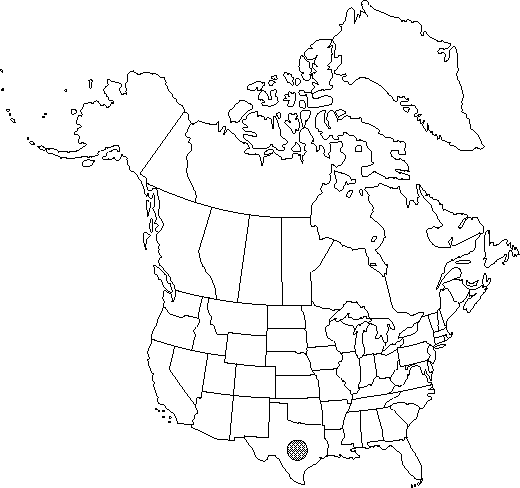Difference between revisions of "Berberis swaseyi"
Famil. Lessons Bot., 152. 1873.
FNA>Volume Importer |
imported>Volume Importer |
||
| (7 intermediate revisions by 2 users not shown) | |||
| Line 15: | Line 15: | ||
|name=Mahonia swaseyi | |name=Mahonia swaseyi | ||
|authority=(Buckley ex M. J. Young) Fedde | |authority=(Buckley ex M. J. Young) Fedde | ||
| + | |rank=species | ||
}} | }} | ||
|hierarchy=Berberidaceae;Berberis;Berberis swaseyi | |hierarchy=Berberidaceae;Berberis;Berberis swaseyi | ||
| Line 23: | Line 24: | ||
}}<!-- | }}<!-- | ||
| − | --><span class="statement" id="st- | + | --><span class="statement" id="st-undefined" data-properties=""><b>Shrubs,</b> evergreen, 1-2 m. <b>Stems</b> ± dimorphic, with elongate primary and short or somewhat elongate axillary shoots. <b>Bark</b> of 2d-year stems purple, glabrous. <b>Bud</b> scales 1.5-4 mm, deciduous. <b>Spines</b> absent. <b>Leaves</b> 5-9-foliolate (basal pair of leaflets sometimes reduced to bristles); petioles 0.1-0.5 cm. <b>Leaflet</b> blades thin or thick and rigid; surfaces abaxially dull, papillose, adaxially dull, somewhat glaucous; terminal leaflet stalked (sessile in a few leaves), blades 1.8-3.5 × 0.7-1.7 cm, 1.3-4.7 times as long as wide; lateral leaflets oblong to elliptic or lanceolate, 1-veined from base, base truncate to obtuse, rarely acute, margins plane or undulate, toothed, each with 3-8 teeth 0.5-2 mm high tipped with spines to 0.6-1.2 × 0.1-0.2 mm, apex rounded to acuminate. <b>Inflorescences</b> racemose, lax, 2-6-flowered, 4-6 cm; bracteoles leathery, apex spinose-acuminate, sometimes with proximal bracteoles as described, distal membranous and acuminate. <b>Flowers</b>: anther filaments with distal pair of recurved lateral teeth. <b>Berries</b> white or red and somewhat glaucous, spheric, 9-16 mm, dry or juicy, hollow.</span><!-- |
-->{{Treatment/Body | -->{{Treatment/Body | ||
| Line 30: | Line 31: | ||
|elevation=150-600 m | |elevation=150-600 m | ||
|distribution=Tex. | |distribution=Tex. | ||
| − | |discussion=<p>Berberis swaseyi is endemic to the Edwards Plateau. According to M. C. Johnston (pers. comm.), B. swaseyi and B. trifoliolata hybridize in central Texas.</p><!-- | + | |discussion=<p><i>Berberis swaseyi</i> is endemic to the Edwards Plateau. According to M. C. Johnston (pers. comm.), <i>B. swaseyi</i> and <i>B. trifoliolata</i> hybridize in central Texas.</p><!-- |
| − | --><p>Berberis swaseyi is susceptible to infection by Puccinia graminis.</p> | + | --><p><i>Berberis swaseyi</i> is susceptible to infection by Puccinia graminis.</p> |
|tables= | |tables= | ||
|references= | |references= | ||
| Line 40: | Line 41: | ||
-->{{#Taxon: | -->{{#Taxon: | ||
name=Berberis swaseyi | name=Berberis swaseyi | ||
| − | |||
|authority=Buckley ex M. J. Young | |authority=Buckley ex M. J. Young | ||
|rank=species | |rank=species | ||
| Line 55: | Line 55: | ||
|publication year=1873 | |publication year=1873 | ||
|special status=Endemic | |special status=Endemic | ||
| − | |source xml=https:// | + | |source xml=https://bitbucket.org/aafc-mbb/fna-data-curation/src/2e0870ddd59836b60bcf96646a41e87ea5a5943a/coarse_grained_fna_xml/V3/V3_917.xml |
|genus=Berberis | |genus=Berberis | ||
|species=Berberis swaseyi | |species=Berberis swaseyi | ||
| − | |||
| − | |||
| − | |||
| − | |||
| − | |||
| − | |||
| − | |||
| − | |||
| − | |||
| − | |||
| − | |||
| − | |||
| − | |||
| − | |||
| − | |||
| − | |||
| − | |||
| − | |||
| − | |||
| − | |||
| − | |||
| − | |||
| − | |||
| − | |||
| − | |||
| − | |||
| − | |||
| − | |||
| − | |||
| − | |||
| − | |||
| − | |||
| − | |||
| − | |||
| − | |||
| − | |||
| − | |||
| − | |||
| − | |||
| − | |||
| − | |||
| − | |||
| − | |||
| − | |||
| − | |||
}}<!-- | }}<!-- | ||
-->[[Category:Treatment]][[Category:Berberis]] | -->[[Category:Treatment]][[Category:Berberis]] | ||
Latest revision as of 21:52, 5 November 2020
Shrubs, evergreen, 1-2 m. Stems ± dimorphic, with elongate primary and short or somewhat elongate axillary shoots. Bark of 2d-year stems purple, glabrous. Bud scales 1.5-4 mm, deciduous. Spines absent. Leaves 5-9-foliolate (basal pair of leaflets sometimes reduced to bristles); petioles 0.1-0.5 cm. Leaflet blades thin or thick and rigid; surfaces abaxially dull, papillose, adaxially dull, somewhat glaucous; terminal leaflet stalked (sessile in a few leaves), blades 1.8-3.5 × 0.7-1.7 cm, 1.3-4.7 times as long as wide; lateral leaflets oblong to elliptic or lanceolate, 1-veined from base, base truncate to obtuse, rarely acute, margins plane or undulate, toothed, each with 3-8 teeth 0.5-2 mm high tipped with spines to 0.6-1.2 × 0.1-0.2 mm, apex rounded to acuminate. Inflorescences racemose, lax, 2-6-flowered, 4-6 cm; bracteoles leathery, apex spinose-acuminate, sometimes with proximal bracteoles as described, distal membranous and acuminate. Flowers: anther filaments with distal pair of recurved lateral teeth. Berries white or red and somewhat glaucous, spheric, 9-16 mm, dry or juicy, hollow.
Phenology: Flowering winter–spring (Feb–Apr).
Habitat: Limestone ridges and canyons
Elevation: 150-600 m
Discussion
Berberis swaseyi is endemic to the Edwards Plateau. According to M. C. Johnston (pers. comm.), B. swaseyi and B. trifoliolata hybridize in central Texas.
Berberis swaseyi is susceptible to infection by Puccinia graminis.
Selected References
None.
